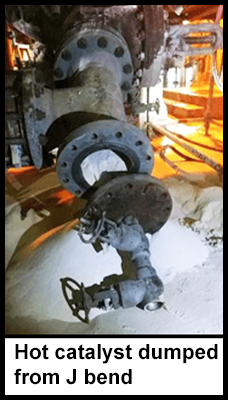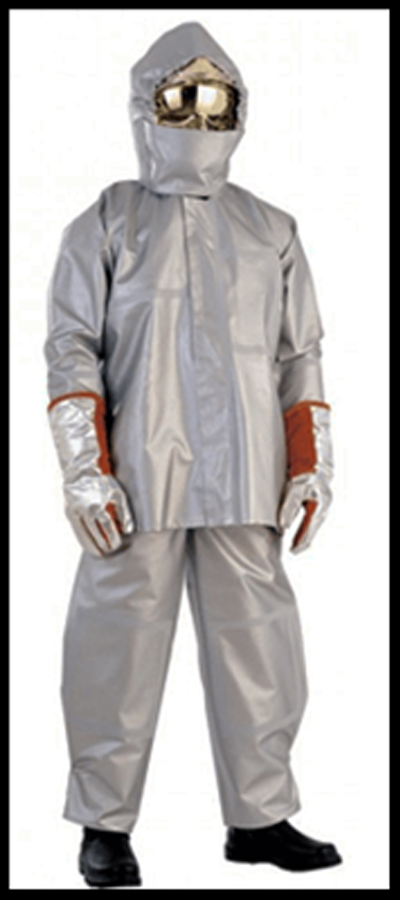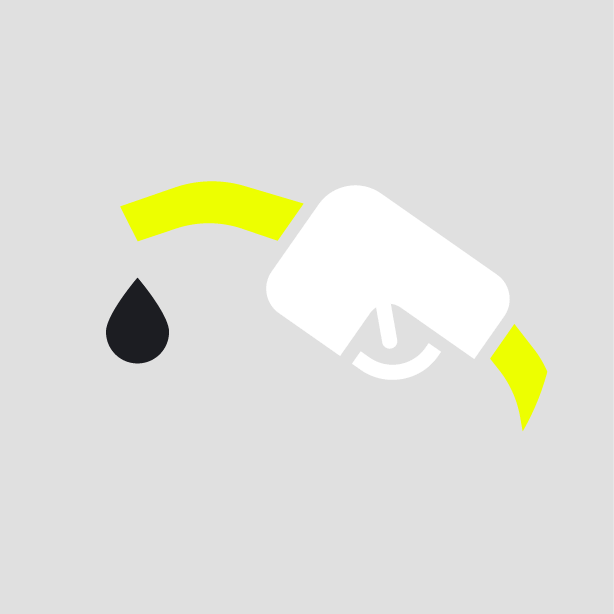-
What happened?
Two pipefitters were loosening bolts to roll a blind flange.
Residual hot catalyst was released from the line, burning the wrists of one of the workers.

-
Why did it happen?
The piping system was not locked, tagged out, and tried (LTT) to verify a zero energy state before permitting the work.
Only supervisors attended life critical training.
No work verification tags were used and operations staff were not present during the first breaking of containment.
Presence of residual catalyst in the line was not recognized as a potential hazard (>1500 F/815.5 C).
Thermal personal protective equipment (PPE) was available for use, but not required by the permit.

-
What did they learn?
Open bleeders are not adequate verification of ‘zero energy’ state.
- Require personnel working in process units to attend life critical ((locked, tagged out, and tried (LTT)) training prior to work.
- Incorporate design changes for J-bend replacement projects to allow residual drainage with less potential for exposure.
Residual catalyst in the J-bend can stay hot for days after shutdown, because the piping is refractory lined and catalyst is an insulator.
- Update shutdown procedure and standards to require thermal protective gear. Define wrist, ankle and face protection gear.
Include in training:
- Maintenance/contractors are not allowed to provide operator assistance during start up/shut down.
- Every job task requires a permit.
- If there is no tag, do not break the line (‘No tag = no line break’).

-
Ask yourself or your crew
What other actions could have been taken?
If this were to occur on our site, what would be our local site management's reaction? Would it be of blame of the work crew or would it being trying to understand why the work crew did the work in the manner it had?
Why do you think:
- ‘zero energy’ state was not confirmed before starting the work?
- only supervisors attended the life critical training and the pipefitters did not?
On our site, how would we know it was safe to break the line? Is this always done correctly?

Add to homescreen
Content name
Select existing category:
Content name
New collection
Edit collection
What happened?
Two pipefitters were loosening bolts to roll a blind flange.
Residual hot catalyst was released from the line, burning the wrists of one of the workers.

Why did it happen?
The piping system was not locked, tagged out, and tried (LTT) to verify a zero energy state before permitting the work.
Only supervisors attended life critical training.
No work verification tags were used and operations staff were not present during the first breaking of containment.
Presence of residual catalyst in the line was not recognized as a potential hazard (>1500 F/815.5 C).
Thermal personal protective equipment (PPE) was available for use, but not required by the permit.

What did they learn?
Open bleeders are not adequate verification of ‘zero energy’ state.
- Require personnel working in process units to attend life critical ((locked, tagged out, and tried (LTT)) training prior to work.
- Incorporate design changes for J-bend replacement projects to allow residual drainage with less potential for exposure.
Residual catalyst in the J-bend can stay hot for days after shutdown, because the piping is refractory lined and catalyst is an insulator.
- Update shutdown procedure and standards to require thermal protective gear. Define wrist, ankle and face protection gear.
Include in training:
- Maintenance/contractors are not allowed to provide operator assistance during start up/shut down.
- Every job task requires a permit.
- If there is no tag, do not break the line (‘No tag = no line break’).
Ask yourself or your crew
What other actions could have been taken?
If this were to occur on our site, what would be our local site management's reaction? Would it be of blame of the work crew or would it being trying to understand why the work crew did the work in the manner it had?
Why do you think:
- ‘zero energy’ state was not confirmed before starting the work?
- only supervisors attended the life critical training and the pipefitters did not?
On our site, how would we know it was safe to break the line? Is this always done correctly?
A worker received burns on wrist after residual hot catalyst was released from a line. ‘Zero energy’ state was not confirmed before starting the work and although available, thermal PPE was not required on the permit to work.











